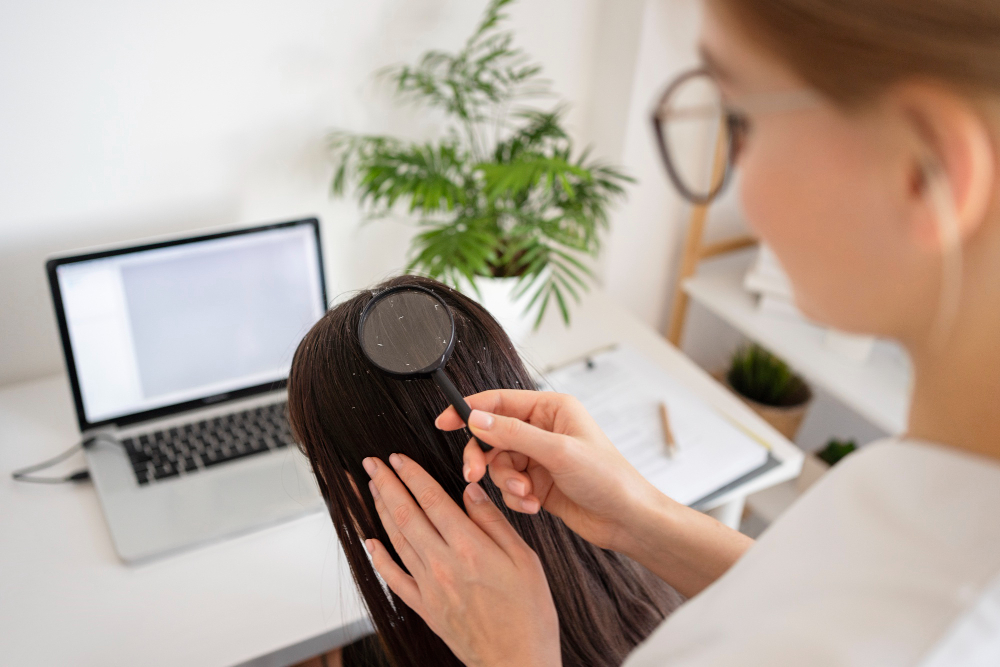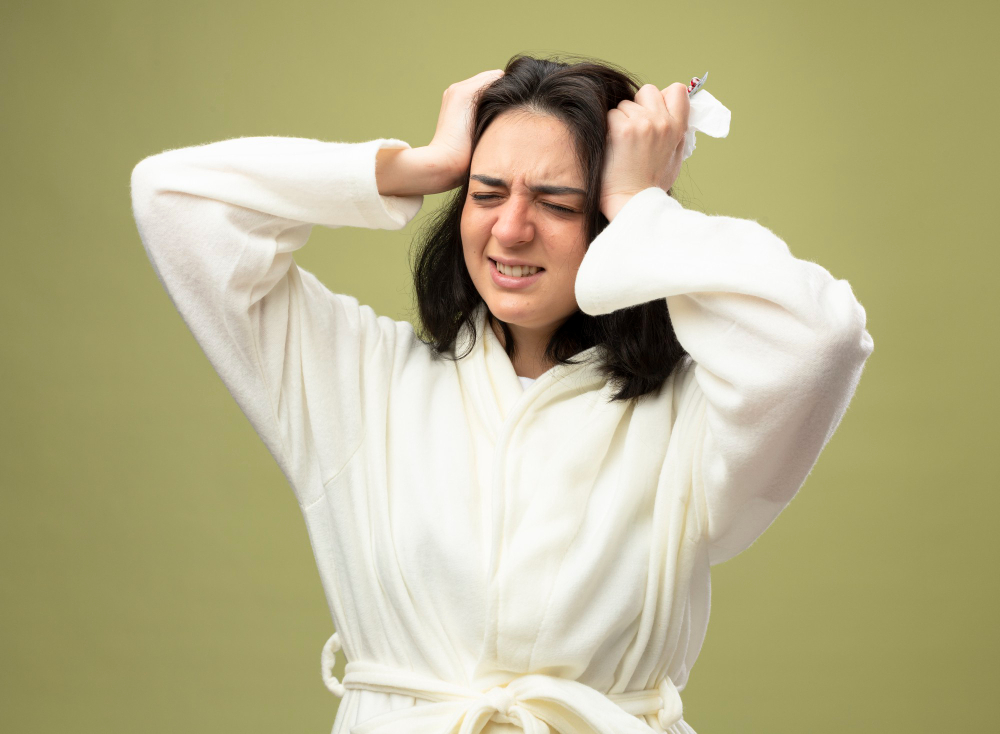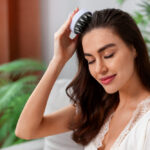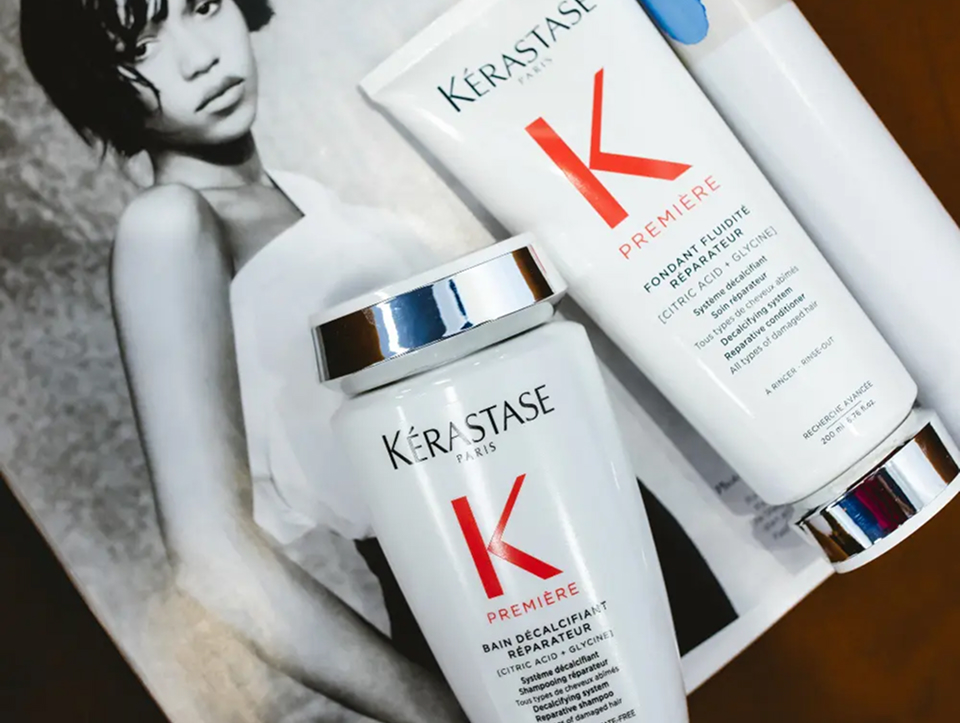If your scalp flakes, it’s tempting to assume it’s just dryness or maybe dandruff. But knowing the difference between dandruff vs. dry scalp is crucial for treating the root cause.
These two conditions may share symptoms like itching and flaking, but they stem from opposite problems: oil overload vs. moisture deficiency. In this guide, you’ll finally uncover the science behind the flakes, and learn how to treat each condition for a healthier, calmer scalp.
Dandruff vs. Dry Scalp: Key Differences Explained

Understanding the difference between dandruff and dry scalp is essential because treating one like the other can worsen your symptoms. Below is a quick comparison to help you spot which condition you’re dealing with:
Key Differences Between Dandruff vs. Dry Scalp
| Condition | Primary Cause | Flake Appearance | Common Triggers | Best Treatment Options |
|---|---|---|---|---|
| Dandruff | Overgrowth of Malassezia yeast and excess sebum (oil) | Large, oily flakes that may appear yellow or white | Hormonal changes, stress, infrequent washing, and product buildup | Medicated shampoos with ketoconazole, zinc pyrithione, or selenium sulfide; scalp exfoliation; clarifying routines |
| Dry Scalp | Loss of moisture or skin sensitivity | Fine, dry, white flakes that fall easily | Cold weather, over-washing, harsh products, eczema, dehydration | Hydrating shampoos, scalp oils, weekly deep conditioning, humidifier use |
💡 Also, learn the difference between dandruff and product buildup.
Dandruff: How to Spot It & Treat It Right

Cause:
Dandruff stems from an overgrowth of Malassezia yeast, triggered by excess sebum. This imbalance causes scalp inflammation and faster skin turnover. In more severe cases, it becomes seborrheic dermatitis.
Appearance:
Look for larger, oily flakes, white or yellow, stuck to the scalp or hairline. They’re harder to brush off and often come with redness or itchiness.
Triggers:
- Stress
- Hormonal changes
- Infrequent washing
- Product buildup
- Seasonal changes
Do
💡Learn more about oily scalp and flake control
Best Treatments:
- Medicated shampoos with ketoconazole or selenium sulfide
- Weekly scalp exfoliation
- Cleaning your brushes regularly to avoid reinfection
- If symptoms persist, consider a professional scalp analysis
- Severe cases may be linked to psoriasis
💡Tip: Skip heavy oils or hair butters, as they can feed the yeast and worsen dandruff.
Dry Scalp: Why It Happens & What to Do

Cause:
Dry scalp is usually due to a lack of moisture, not an oil imbalance—harsh products, cold air, and overwashing strip away natural oils, leading to flakiness.
Appearance:
Flakes are small, dry, and powdery, often falling onto clothes. You might also feel tightness or irritation.
Triggers:
- Cold/dry weather
- Sulfates and alcohol in shampoos
- Overwashing
- Aging skin
- Eczema/contact dermatitis
👉Discover what causes dry scalp
👉Bust hair care myths that could be making it worse.
Best Treatments:
- Switch to a gentle, sulfate-free shampoo
- Use deep conditioning masks weekly
- Add a humidifier during colder months
- Try a tailored scalp therapy treatment
💡Tip: Dry scalp doesn’t always mean dry hair if your ends feel fine but your scalp is flaking, it’s likely an external factor, not your natural texture.
How to Tell Them Apart (Visually)
- Dandruff flakes are larger, waxy, and may look yellowish or oily.
- Dry scalp flakes are smaller, white, and often shed like dust.
- Dandruff tends to form in patches with redness, while dry scalp may appear uniformly irritated.
Not sure what you’re dealing with? Book a professional scalp analysis at Haste in Boston for answers.
Treatments for Dandruff vs. Dry Scalp

With both scalp conditions, you can find multiple things to do to treat both conditions, even changing your scalp care routine by season:
Dandruff
Target the root cause: oil imbalance and yeast.
1. Medicated Shampoos
Use twice a week. Look for ingredients like:
- Ketoconazole
- Zinc pyrithione
- Salicylic acid
- Selenium sulfide
These break down oil and reduce Malassezia. Brands like Kérastase offer luxury dandruff solutions that treat without stripping.
2. Omega-3 Fatty Acids
Promote scalp balance and reduce inflammation. Try flaxseed, walnuts, or fish oil.
3. Vitamin D3
According to the AAD, vitamin D helps regulate skin cell growth and reduce flaking.
4. Tea Tree Oil
Antimicrobial, anti-inflammatory — but dilute it! Or look for it in your shampoo.
5. Reduce Stress
Exercise, sleep, and meditation can reduce flare-ups triggered by cortisol.
💡Tip: Check your brush. A dirty brush can reintroduce flakes. Learn how to clean it properly.
Dry Scalp
Focus on hydration and gentleness.
1. Scalp Therapy Treatments
Try a professional scalp treatment or visit our Boston salon for in-chair scalp therapy.
2. Use Gentle, Sulfate-Free Products
Avoid alcohols, parabens, and synthetic fragrances. Your scalp barrier needs protection.
3. Wash Less Often
Daily washing strips natural oils. Switch to every 2–3 days and use lukewarm water.
4. Humidifier at Home
Hydrates both skin and scalp, especially in winter or dry climates.
5. Probiotics
Supports your skin microbiome, whether through topical application or dietary intake.
6. Avoid Heat Styling
If you must, always use a heat protectant.
💡Tip: Check out these DIY remedies for your dry scalp.
When to See a Doctor

See a dermatologist if:
- Flakes worsen despite using medicated products
- Your scalp is red, swollen, or scabbing
- Hair loss or inflammation spreads
You may have a more complex condition like psoriasis, seborrheic dermatitis, or eczema.
Dandruff vs. Dry Scalp Doesn’t Have to Be Confusing
Still unsure whether you’re battling dandruff or a dry scalp? You’re not alone. While both conditions cause flaking and itching, their root causes and treatments are very different.
Dandruff is often the result of fungal overgrowth and excess oil, while dry scalp is typically linked to dehydration and sensitivity.
The best way to regain scalp health is to understand your unique condition and treat it accordingly. Use gentle, hydrating products for dry scalp and targeted, medicated treatments for dandruff. Don’t forget: seasonal changes, stress, and product choices all play a role!
Let Haste Hair help! Book a professional scalp analysis and let our expert stylists tailor the best plan for your scalp health.
Ready for relief? Book your scalp consultation now →
FAQ
What’s the difference between dandruff and dry scalp?
Dandruff is caused by excess oil and Malassezia yeast, producing oily, larger flakes. Dry scalp stems from dehydration, making fine, powdery flakes with no oil buildup.
Can dandruff shampoo cause dry scalp?
Yes. Overusing shampoos that contain coal tar or salicylic acid, and skipping conditioner can strip natural oils and lead to dryness.
Will dry scalp cause hair loss?
Chronic dryness and inflammation can weaken follicles over time, potentially contributing to hair thinning, but it’s preventable with proper care.
How can I tell if I have fungal dandruff or just dry flakes?
Oily patches, redness, and yellow flakes often accompany dandruff. For certainty, a professional scalp analysis is the best path.
What shampoo ingredients help dandruff vs. dry scalp?
For dandruff: look for ketoconazole, zinc pyrithione, or selenium sulfide. For a dry scalp, look for hydrating, sulfate-free products and consider weekly scalp moisturizers.









